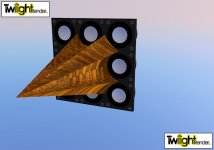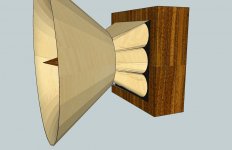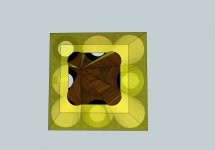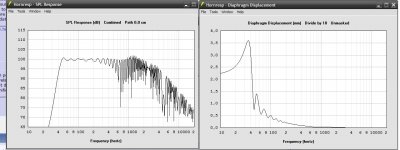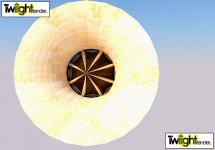the distance between it and the sum of the membran area is the problem for highs, you need
I'm sorry I don't know what that means, your English isn't the best. The drivers ar directed straight down the nose of the phase plug, there is no chamber for thm to bounce around in, just a narow straight tunnel( a seperate one for each driver) for 5cm flaring to a front horn for 10cm. As far as I now the only thing that negaively affects high frequencies is directionality and reflections, the design doesn't have these problems as far as I know. I'm not saying you're wrong, I just don't see why you're right. I want to build this design to test it but my cabinet guy is very busy for the next few months, the design is very labor intensive(involving the use of a lathe) and rather expensive(large chunks of hardwood) and as I mentioned previously I have no funds. If it would present a problem I could definitely shorten the chamber the reason I have the number in there that I do is because that is what modeled best on hornresp but in actuality I guess there doesn't have to be a chamber at all that's just kinda how it came out in the design for various somewhat arbitrary reasons, but it could be shartened or perhaps even eliminated I guess. Back to the drawing board I guess. I think I spend as much time modeling that front horn (in Sketchup) as I did the whole rest of the design.
Very interesting project. I saw it this morning but had nothing to add until I found this page by random just now.
2010 High End Show Munich

There are a couple of videos in the link above too.
2010 High End Show Munich

There are a couple of videos in the link above too.
Another spiral horn, but I have yet to see anyone try the multi-driver arrangement being shown in development. Then again I'm no expert, just surf'n.
Project | Homebuilt Hi-Fi - A user submitted image showcase of high quality home built hi-fi components.


Project | Homebuilt Hi-Fi - A user submitted image showcase of high quality home built hi-fi components.


Hi, I am a bit worried about interference between the drivers. I suspect you will be losing some high frequency at around 10kHz+, I hope I am wrong though.
i don´t think so,
simus are only for 3 oktaven correct, from the flare rate as the base
Well sence this is a compound horn and thereby simulating two horns it is as I have always suspected acurate to 6 octives ergo to about 2K. But the highs travel straight down the nose of the phase plug to the listeners ears. Nothing is blocking them they are not turning any curves they are in essence acting as direct radiators and should be unaffected by the horn.
Actually because of the phase plug there would be no destructive interference. All 8 of the drivers are essensially equidistant from the tip of the phase plug(4 of the drivers ar 11/32" or .8mm farther from the tip) and the "chamber" which is really 8 seperate wave guides and not a chamber at all, directs the sound directly to the center thereby ensuring all drivers are working in unison throughout the the spectrum.Hi, I am a bit worried about interference between the drivers. I suspect you will be losing some high frequency at around 10kHz+, I hope I am wrong though.
And BTW HM I have posted nearly all of my designs on this forum. The fact that you don't want to bother looking for them doesn't give you the right to call me inexperienced. How many of your designs have you shared? How many have you designed? If anyone wants to see my designs they can look at my posts I am tired of being asked for my credentials by you every time I post. Everyone else seems to be able to find enough of my posts to trust my judgement. Many of the speakers I have help build and test were designs of my collegue, and he does not wish to share them. So until you do your homework and show your answers, stop your naysaying.
If you want to see multiple drivers in a front horn configuration do a search for the "Unity Horn" design. It is a comercial design that is widely used and highly aclaimed. I have not stolen it, only used it's basic principles and, I hope, improved upon it. It does not benifit from the phase plug my design has and does not suffer from the high frequency problems everyone seems so concerned about.
Alright in this picture I have completely deleted the front horn so you can see how all eight drivers point directly down the phase plug. they are almost exactly eqidistant from the tip and should combine perfectly smothly in the high frequencies.There is no chamber for the sound to bounce around in or any cross paths for them to cancel out in. I have considered and dealt with all of these concerns and all anyone can do is shake their head and say "because I didn't think of it and I don't understand it, it won't work!" I am not saying I know everything and there isn't anything I haven't considred I'm just saying if there is, nobody has mentioned it.
Attachments
Last edited:
Brsanko,
Nearly equidistant is not equidistant, many line array systems are suffering from the same problem although theoretically they should work perfectly. The combing effect is still there, maybe some are alright on axis, but off axis would be ragged and requires DSP and equalization.
I think nearly all of us here on the forum are trying our best to share our knowledge and experience with the others, and most if not all comments are friendly and useful. To me, hm is a honorable gentleman who is trying to raise some questions and problems that you may have to face in your design. I guess as some of us are not native English speakers, our words may not accurately and faithfully tell what we want to tell, sometimes we use the wrong choices of words or tones without noticing it, and it may soon turn into arguments, what a pity.
I was banged by a lot of other helpful gentlemen here on this forum, and most of the time they give me valuable lessons based on their own past experience.
Boris
Nearly equidistant is not equidistant, many line array systems are suffering from the same problem although theoretically they should work perfectly. The combing effect is still there, maybe some are alright on axis, but off axis would be ragged and requires DSP and equalization.
I think nearly all of us here on the forum are trying our best to share our knowledge and experience with the others, and most if not all comments are friendly and useful. To me, hm is a honorable gentleman who is trying to raise some questions and problems that you may have to face in your design. I guess as some of us are not native English speakers, our words may not accurately and faithfully tell what we want to tell, sometimes we use the wrong choices of words or tones without noticing it, and it may soon turn into arguments, what a pity.
I was banged by a lot of other helpful gentlemen here on this forum, and most of the time they give me valuable lessons based on their own past experience.
Boris
Brsanko,
Well, you just insulted me too by saying what non-native speakers said is gibberish. I never say you should give up the design, maybe it will work, maybe it will not. I believe hm was just trying, from the point of view of an experienced horn designer, that your design is more fanatic than practical. Actually, with such an elaborated design, I am sure you can have better results with larger drivers than those tiny 1" TBs, which are, by the way, supposed to be high passed instead of running full range as suggested by Parts-Express. I guess with those drivers, you must be very lucky to get 100Hz. Just one more suggestion, well, it's not your fault, that Tangband have a track record of overrating their drivers, I suspect their Fs is not 170Hz, seems more like 200Hz+ to me. I think you will have much better results with Aurasound NSW-1 or NSW-2.
Well, you just insulted me too by saying what non-native speakers said is gibberish. I never say you should give up the design, maybe it will work, maybe it will not. I believe hm was just trying, from the point of view of an experienced horn designer, that your design is more fanatic than practical. Actually, with such an elaborated design, I am sure you can have better results with larger drivers than those tiny 1" TBs, which are, by the way, supposed to be high passed instead of running full range as suggested by Parts-Express. I guess with those drivers, you must be very lucky to get 100Hz. Just one more suggestion, well, it's not your fault, that Tangband have a track record of overrating their drivers, I suspect their Fs is not 170Hz, seems more like 200Hz+ to me. I think you will have much better results with Aurasound NSW-1 or NSW-2.
 Many posts pulled. brsanko and hm, either follow the forum rules (no personal attacks) or your posting privileges will be suspended or revoked. I get very grumpy when people make work for me, and you don't want me grumpy.
Many posts pulled. brsanko and hm, either follow the forum rules (no personal attacks) or your posting privileges will be suspended or revoked. I get very grumpy when people make work for me, and you don't want me grumpy.No further warnings.
I fully intend to but this forum is about sharing ideas too. Not just finished designs and measurments. Yes I am a dreamer and that is why I am so creative. I am a writer, a painter, a drawer, an actor, an engineer, a singer, being negatively critisized doesn't help improve any of these arts. If you have a critisizm lead with a complement, I'm sure you can find plenty good to say about my design if you want to. The reason I have the initial path from the drivers to the horn throat is that without it the throat would be too big to give the gain in the 900-2000hz region that the design needs. As far as I can tell the shape of the path combined with the phase plug should prove to improve the HF not degrade it. Is a .8mm path difference really enough distance to cause a considerable comb filter effect? I mean that is much smaller than different parts of the same cone in some fullrange drivers. Aren't the benifits of the design enough to out weigh such tiny imperfections? This really seems like a fantastic design to me. Granted it's not perfect but what design is? I have yet to see any substantial critisizms that would make it a bad design or even a mediocre one. Yet nobody seems to want to praise it's good qualities. I really haven't built too many of my own designs to post on here. I have helped design dozens of spakers but as I mentioned some of the credits of those goto my partner and he doesn not wish to share them. I have not done a lot of measurements because as of yet I lack a suitable room in which to do such measurements. But I do know that all of our designs have ended up sounding exactly as we pridicted they would. I know this doesn't sound like much to a scientist but Doug and I do have quite keen ears and are both of an analytical mindset. I will build these but it will be at least several months in the future. I also have built designs with much larger front horns and chambers that have had more than sufficient HF response. These things are all aspects to consider but I have considered them and weighed them and I feel come up with the best compromise.
Brsanko,
1. Well, you just insulted me too by saying what non-native speakers said is gibberish.
2.I am sure you can have better results with larger drivers than those tiny 1" TBs,
3.which are, by the way, supposed to be high passed instead of running full range as suggested by Parts-Express.
4.I guess with those drivers, you must be very lucky to get 100Hz. Just one more suggestion, well, it's not your fault, that Tangband have a track record of overrating their drivers, I suspect their Fs is not 170Hz, seems more like 200Hz+ to me. I think you will have much better results with Aurasound NSW-1 or NSW-2.
1. That's not what I said or meant.
2. The small size an this ultra low weight and high stiffness is what gives
these drivers their advantage, in every aspect we have discussed.
Changing the Fs to 200hz would have very Little affect on the response
of this design.
I have already used these drivers in another much smaller bookshelf
design, where they perform very nicely down to 80hz, albeit with only
one driver so not crazy loud, but exactly as modeled in hornresp all the
same, or rather a bit better. The listed Xmax for these drivers (the real
critical measurement when it comes to bass in horns) is 1.95mm, I
believe this to be very acurate as the mechanical movement is at least
3-4mm before they bottom out or pop.
3. You'll notice all of the other suggestions for designs from P.E. are for
sealed or ported designs, in such designs these drivers wouldn't have
much response below that frequency anyway and would bottom out
if you tried to force them. This is not necessarily the case with a horn is
the excersion of the driver is very acurately modeled by hornresp and has
been considered in all of my designs.
4. I have had nothing but possitive experiences with TB drivers and I have
pesonally purchased at least 10 of their drivers in all different sizes and
they have all performed well and measured within 10-15% of spec with
the WT3. I have also modeled the Aurasound drivers and have had
better sims with the TBs, perhaps the Auras will have better real world
performance I don't know I haven't tried them but I so far have had no
reason to be disatisfied with anything from TB.
Hello,
"The listed Xmax for these drivers (the real
critical measurement when it comes to bass in horns) is 1.95mm, I
believe this to be very acurate as the mechanical movement is at least
3-4mm before they bottom out or pop."
How much distortion you will get? 40% or more?
"The listed Xmax for these drivers (the real
critical measurement when it comes to bass in horns) is 1.95mm, I
believe this to be very acurate as the mechanical movement is at least
3-4mm before they bottom out or pop."
How much distortion you will get? 40% or more?
at 3 or 4mm perhaps but I'm not pushing them that hard. if you look at my sims the speakers reach 120db at 2mm down to 50hz, so at normal listening levels you will never even get close to that. At 100db the excursion peaks at .35mm at 35 hz, well below the intended band width. at 45hz and above it doesn't exceed .15mm at this volume. I don't think it would ever be a problem if used properly and it could play ear splitting volumes without significant distortion if crossed over above 50hz, it's intended extention.
 More posts pulled. hm and brsanko have failed to follow specific moderator directives. They will be in read-only mode for the next several days until they learn either to use the "ignore" button, "ignore" without software assistance, or deal with one another in the professional manner called for by this site's rules.
More posts pulled. hm and brsanko have failed to follow specific moderator directives. They will be in read-only mode for the next several days until they learn either to use the "ignore" button, "ignore" without software assistance, or deal with one another in the professional manner called for by this site's rules.1. That's not what I said or meant.
2. The small size an this ultra low weight and high stiffness is what gives
these drivers their advantage, in every aspect we have discussed.
Changing the Fs to 200hz would have very Little affect on the response
of this design.
I have already used these drivers in another much smaller bookshelf
design, where they perform very nicely down to 80hz, albeit with only
one driver so not crazy loud, but exactly as modeled in hornresp all the
same, or rather a bit better. The listed Xmax for these drivers (the real
critical measurement when it comes to bass in horns) is 1.95mm, I
believe this to be very acurate as the mechanical movement is at least
3-4mm before they bottom out or pop.
Firstly, it's good to see that you have come up with a "full range" design for the 1" TB driver, despite the naysayers. The front horn portion with unique phase plug is quite creative. How much loss of highs is hard to predict in this front horn, and in the end the proof will be in the listening- as it is with all speaker designs regardless of how well it sims.
Could you provide more details (size and measurements) on the smaller bookshelf speaker that reaches down to 80Hz? Or you could start another thread as there might be others who will be interested in it. Thanks.
I think some differentiating is in order here!
I think most here would agree that there is a marked difference between a model/3d render of a design, and the real world iteration of that design. With that said, it seems you have the former part of that differentiation brsanko, and we thank you for sharing it. You obviously have skill with hornresp and sketchup, far more than I'd ever have the patience/time to acquire.
I do hope that you build some of the designs you've posted here......but there's one oversight......compression (if you intend for the drivers to see <200hz). It's not an oversight on your part, just a thing that modeling programs do not account for. The bi-product of that is some ugly, very ugly lower midrange/upper midbass. I truly hope I end up eating my words, but that driver(s) is going to be screaming for mercy below 200hz......to get to 120db that is. I've heard a handful of designs that were over-ambitious in the bass extension department, and although they worked......the bass as I recall was artificial sounding to my ears.
Ferdinand Porsche was ridiculed for years for putting engines behind the rear axle of his cars.
Hopefully in this post I've met your requirements, as in doling out merit before any critiquing is done.
I think most here would agree that there is a marked difference between a model/3d render of a design, and the real world iteration of that design. With that said, it seems you have the former part of that differentiation brsanko, and we thank you for sharing it. You obviously have skill with hornresp and sketchup, far more than I'd ever have the patience/time to acquire.
I do hope that you build some of the designs you've posted here......but there's one oversight......compression (if you intend for the drivers to see <200hz). It's not an oversight on your part, just a thing that modeling programs do not account for. The bi-product of that is some ugly, very ugly lower midrange/upper midbass. I truly hope I end up eating my words, but that driver(s) is going to be screaming for mercy below 200hz......to get to 120db that is. I've heard a handful of designs that were over-ambitious in the bass extension department, and although they worked......the bass as I recall was artificial sounding to my ears.
Ferdinand Porsche was ridiculed for years for putting engines behind the rear axle of his cars.
Hopefully in this post I've met your requirements, as in doling out merit before any critiquing is done.
Last edited:
Well, I would guess that the fact that these are tiny drivers and require very little power to reach these levels is going to reduce the amount of compression greatly. As to the request to post the bookshelf design, as I mentioned earlier it was designed by my friend Doug and he does not like to share his designs on here and has expressly asked me not to, but if you look at my design using the 2" Tang Band driver that I have links to actual photos of as well as simulations and 3D models, it is very similar only slightly smaller. I have redesigned the front horn phase plug assembly to completly eliminate the front chamber and make all eight driver exactly equidistant from the tip of the plug. I hope this satisfies the critics but I know it won't so, whatever.
Attachments
- Home
- Loudspeakers
- Full Range
- Giant Spiral shaped fiberglass horn for 8 1" Tang Bands
